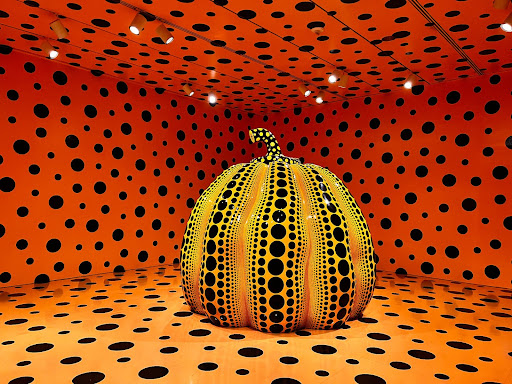Content warning: This article includes references to sexual abuse.
Obtaining a free next-day pass to the Hirshhorn’s One With Eternity: Yayoi Kusama Exhibit is a feat comparable to the Taylor Swift Ticketmaster ordeal—they are snatched up within minutes of their daily noon releases. After the resounding popularity of her 2017 Infinity Mirrors exhibit, the Japanese artist’s work returned to the Hirshhorn last April, powerfully encapsulating Kusama’s message of self-obliteration.
One With Eternity urges visitors to reconceptualize our individuality—a seemingly terrifying process that calls into question one’s self, ego, and identity—but Kusama embraces this process with open arms. Her art abolishes the mindset of seeing ourselves as an entity separate from the rest of the world. Instead, she invites us to melt into the vast oneness of the universe and realize that our existences are inextricably intertwined with those of everything around us.
The infinity rooms—enclosed spaces lined with mirrors to create a sense of, you guessed it, infinity—are clearly the crown jewel of One With Eternity, and for good reason. The visual and spatial overstimulation engulfs visitors so much so that it’s slightly disorienting and nauseating at times. Kusama imposes a dissolution of the self upon the experiencer through her multidimensional works, as one feels like they are being absorbed and incorporated into the art. Time, space, and reality wash away to reveal an eternity of repeating polka dots. And of course, the vivid colors and maximalist patterns are tantalizingly Instagrammable.
“Become one with eternity. Obliterate your personality.” Kusama’s words solemnly greet visitors at the exhibit entrance in the Hirshhorn’s basement, which has been converted into a wonderful miniature universe. Upon checking in, I enter an unassuming room where a timeline narrates Kusama’s life and works in intricate detail. Her childhood and education in Japan is followed by a career kickoff in New York City. Immersive sculpture installations, paint and paper, poetry and prose, performance art and protests—over the course of her seven-decade career, Kusama has infused the contents of her mind across every medium imaginable, using art as a way to manage her lifelong struggle with hallucinations and neurosis.
As debilitating as these issues are, they have also been the impetus behind much of Kusama’s creative vision. From an early age, she found art to be a way to cope with her hallucinations and other psychotic symptoms. Polka dots in particular hold significant importance: Kusama pictures her life to be a singular dot, a particle in a sea of billions and billions of other dots. According to Kusama, “when I am in front of the canvas painting dots, I end up filling the table and the floor and even my own body. The net expands itself to infinity and I forget myself.” Using polka dots allows Kusama to escape the confines of her physical form and the suffering attached to it by dissolving herself into an endless eternity of the circular shapes.
Stepping into the next room is like being splashed by a bucket of ice-cold water: an explosion of orange and black hues meet my eyes; polka dots in every size sprawl along the floor, walls, ceiling; and the eight-foot-tall fiberglass Pumpkin (2016) squats in the middle of the floor. Kusama describes pumpkins as having a “solid spiritual balance.” Standing in the pumpkin’s stately shadow and seeing the blanket of polka dots covering every inch of its surface, I’m inclined to agree. The repeating patterns lend a sense of uniformity and calm to the room.
As I approach the first infinity room, “Phalli’s Field,” I see that the line outside is building up like a clogged artery. As I near the front, the museum employee fires off a brief spiel with the same intensity as that of a prescription drug advertisement disclaimer: You have 35 seconds. No flash photography. No tripods and selfie sticks. I hurriedly step inside a blindingly bright room where the floor is covered with a writhing sea of stuffed, crimson and white polka-dotted canvas penis sculptures. I raise my phone to take a selfie, and a thousand clones mimic my action in the mirrors around me. I kneel down and closely examine the phalli poking up from the ground; each one is unique in shape, size, and polka dot pattern, yet all together they form a cohesive unit, like an endless sea anemone.
Though polka-dotted penises and pumpkins are giggle-inducing, a closer examination reveals much more existential and complicated themes. The soft phallic statues in particular are Kusama’s way of processing the childhood trauma of her mother asking her to spy on her father’s extramarital affairs, leading Kusama to develop a lifelong aversion to sex. Brief mentions of hallucinations and hospitalizations sprinkled throughout the exhibit point to Kusama’s underlying mental health issues. Years of hallucinations, panic attacks, obsessive-compulsive behavior, and suicide attempts cumulated in Kusama checking into a psychiatric institute in 1977, where she resides to this day.
As one proceeds further in the exhibit, “My Heart is Dancing into the Universe” (2018) comes next, another infinity room flanked by a museum employee with a timer. Unlike “Phalli’s Field,” this one isn’t rectangular; it’s shaped like a Tetris Z-Block. Inside, the room is dark except for the colored hues emanating from large spherical paper lanterns floating in the air. The lanterns, reflected over the ceiling, walls, and floors, create a thick fluid that engulfs me. As the lanterns gently change colors, I feel as if I am drifting in a roiling ocean, buoyed by the motion of the orbs around me. My reflection is barely discernible, and I have difficulty telling where my physical form ends and the disorienting ball pit begins. The room is reminiscent of a dark summer field dotted with glowing fireflies. In a startling return to the real world, the signs leading out of the infinity room deposit me in an antechamber where a black and white portrait of Kusama hanging on the wall bids adieu to the visitors trickling out.
Chaotic, calm, contradictory–Kusama’s work contains multitudes. The exhibits in One With Eternity communicate feelings and ideas wordlessly, breaking down the barriers between our minds and welcoming us into Kusama’s mysterious, wonderful, confusing, and frightening eternity. If you have the opportunity to visit and self-obliterate for a little bit, I strongly recommend the experience.
One With Eternity is on display until March 1, 2023.





